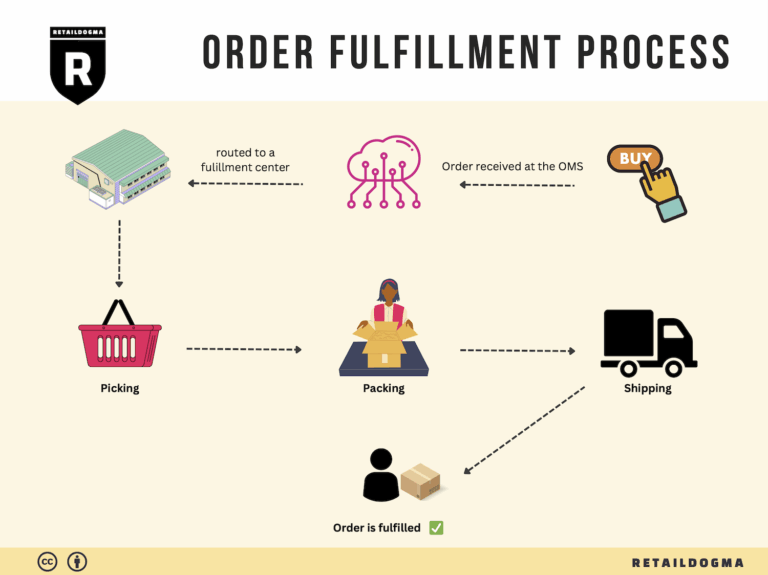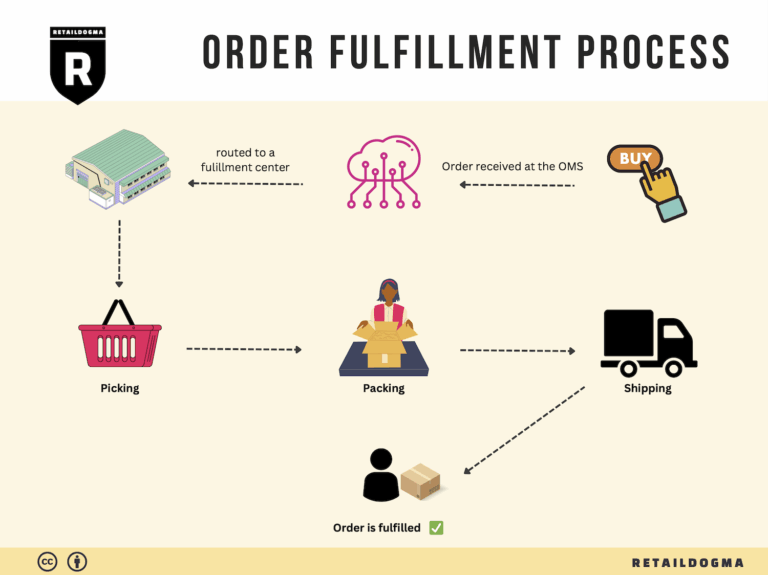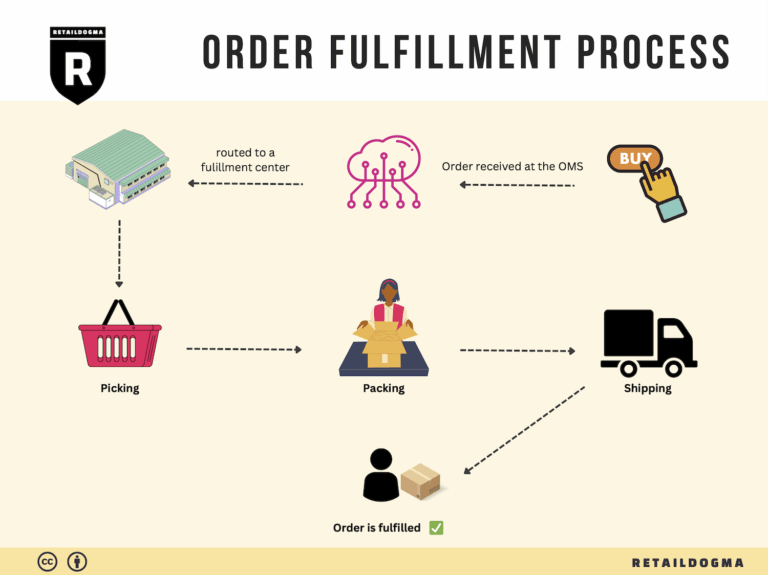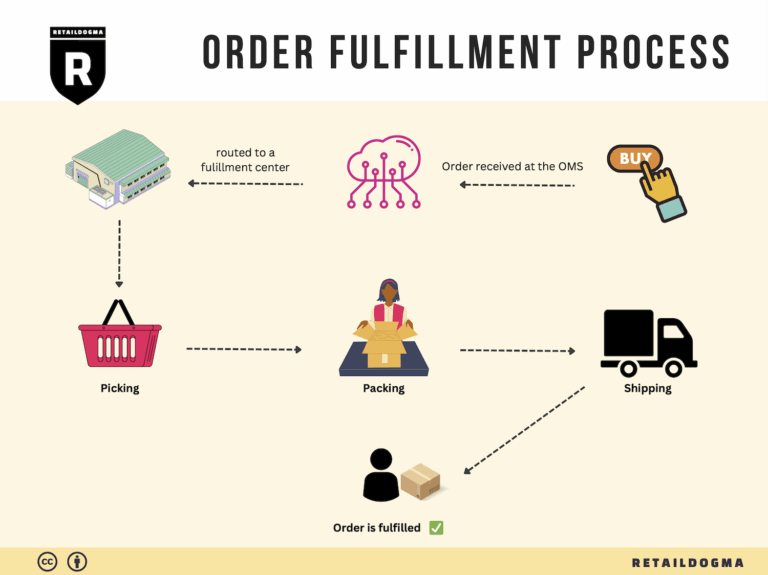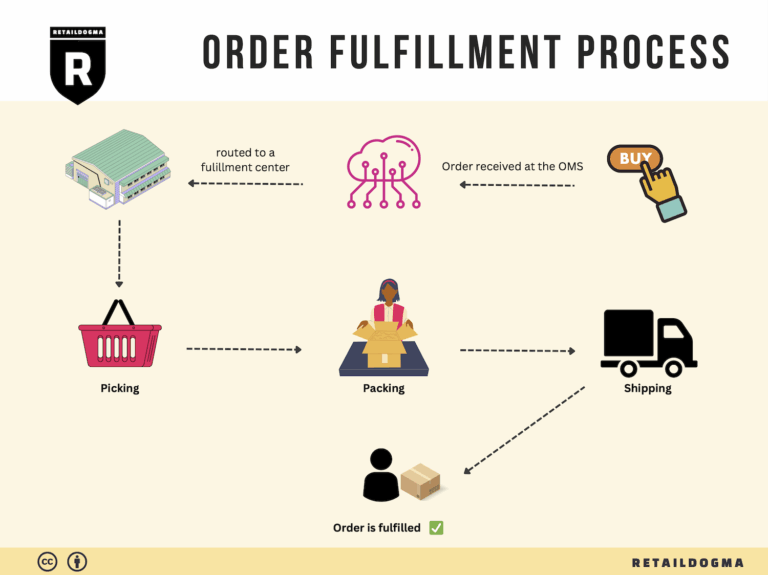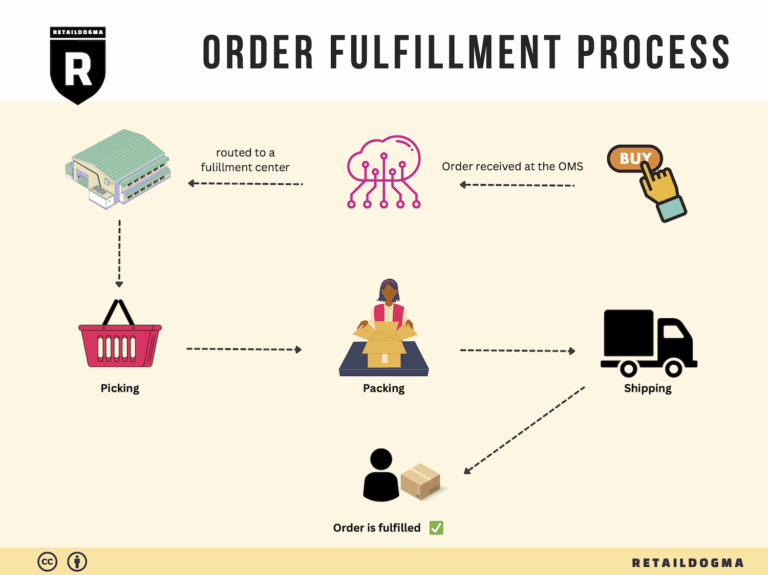How Order Fulfillment Works: A Step-by-Step Guide for Businesses
What is E-commerce Fulfillment? An Introduction for Growing Businesses
Understanding the Challenges of E-commerce Fulfillment
As an e-commerce business owner, you may find yourself grappling with the overwhelming task of packing and shipping orders. Initially, managing these logistics might seem manageable, but as your sales grow, the intricacies of fulfillment can quickly become burdensome. This is where e-commerce fulfillment comes into play—a crucial component of your operations that ensures your products reach your customers in a timely and efficient manner.
At its core, e-commerce fulfillment is the entire process of getting a product from your online store to the customer’s doorstep. This includes receiving inventory, storing products, picking and packing orders, shipping, and managing returns. For growing businesses, understanding this process and its potential impact on customer satisfaction can be a game changer.
What This Guide Will Cover
In this guide, we will explore the various models of e-commerce fulfillment, including Third-Party Logistics (3PL) and Fulfillment by Amazon (FBA). Each model has its benefits and challenges, and understanding these can help you make informed decisions about which path to pursue.
We will delve into the core services provided by fulfillment partners, such as order management, inventory tracking, and returns management. Additionally, we’ll provide insights on how to choose the right fulfillment partner for your unique business needs, including considerations like scalability, technology integration, and customer service.
Pricing is another critical aspect we will discuss. Understanding the cost structures of different fulfillment services can help you budget effectively and avoid unexpected expenses.
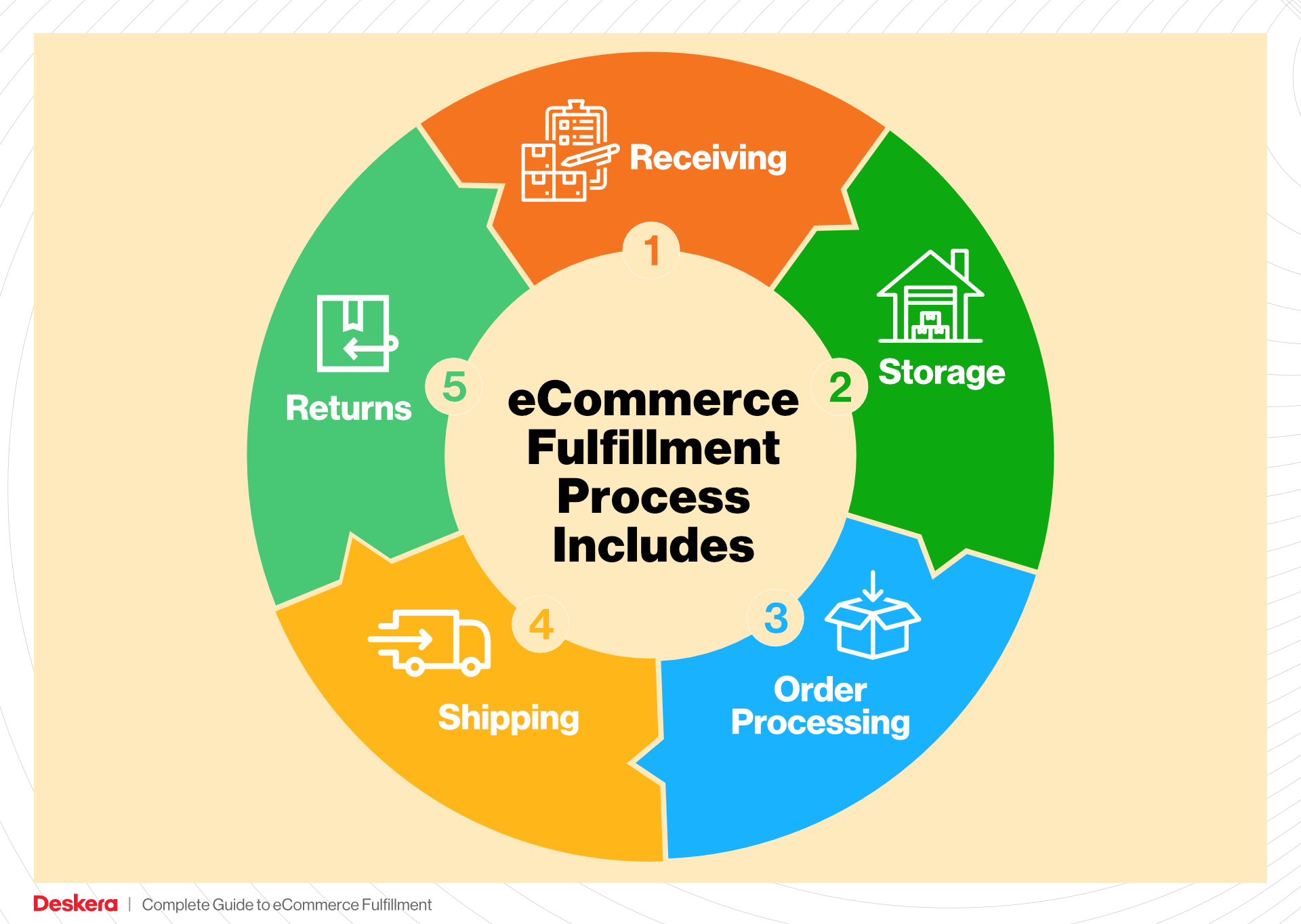
Empowering Smart Logistics Decisions
Ultimately, the goal of this guide is to empower you to make smart, strategic decisions about your logistics operations. By demystifying e-commerce fulfillment and providing practical insights, we aim to equip you with the knowledge necessary to streamline your processes, enhance customer satisfaction, and ultimately, scale your business successfully. Whether you are just starting out or looking to optimize your existing fulfillment strategy, this guide will serve as a valuable resource in navigating the complex world of e-commerce logistics.
What You’ll Learn In This Guide
- What is E-commerce Fulfillment? An Introduction for Growing Businesses
- The Order Fulfillment Process: From ‘Buy’ Button to Customer’s Door
- Comparing Fulfillment Models: In-House vs. 3PL vs. Dropshipping
- A Deep Dive into Amazon FBA: Pros, Cons, and Who It’s For
- Core Services Offered by Fulfillment Centers
- How to Choose a Fulfillment Partner: A 6-Point Checklist
- Understanding Fulfillment Pricing: A Breakdown of Common Fees
- Frequently Asked Questions (FAQs) about Fulfillment
- Conclusion: Is Outsourcing Fulfillment the Right Move for Your Business?
- Important Disclaimer
The Order Fulfillment Process: From ‘Buy’ Button to Customer’s Door
1. Receiving Inventory
The first step in the order fulfillment process begins when your products arrive at your fulfillment center. This stage involves receiving inventory, where goods are checked against purchase orders to ensure accuracy and quality. Key activities include unpacking, inspecting for damages, and sorting items according to their designated storage locations.
Importance: Proper receiving is crucial as it sets the foundation for the entire fulfillment process. Discrepancies at this stage can lead to stockouts or overstock situations, impacting customer satisfaction and operational efficiency. Efficient receiving also minimizes the risk of errors that could escalate into larger issues down the line.
Key Term: SKU (Stock Keeping Unit) – Each product is assigned a unique SKU, which simplifies tracking and inventory management, ensuring that the right products are available when orders come in.
2. Warehouse Storage
Once inventory has been received and verified, the next step is warehouse storage. This process involves organizing products within the fulfillment center in a manner that optimizes space and facilitates easy access. Items are typically stored based on various criteria, including size, weight, and sales velocity.
Importance: Effective warehouse storage is vital for maximizing efficiency in the picking process. A well-organized warehouse reduces the time it takes to locate products, thus speeding up order fulfillment. Furthermore, it helps prevent inventory discrepancies and ensures that stock levels are accurately maintained.
Key Term: Inventory Management System (IMS) – An IMS provides real-time visibility into stock levels and locations, allowing businesses to manage inventory proactively and avoid stockouts or excess inventory.
3. Order Picking
When a customer places an order, the next critical step is order picking, where fulfillment staff retrieve the items from the warehouse to fulfill the order. This process often utilizes pick lists, which are generated based on the SKU and quantity of items ordered.
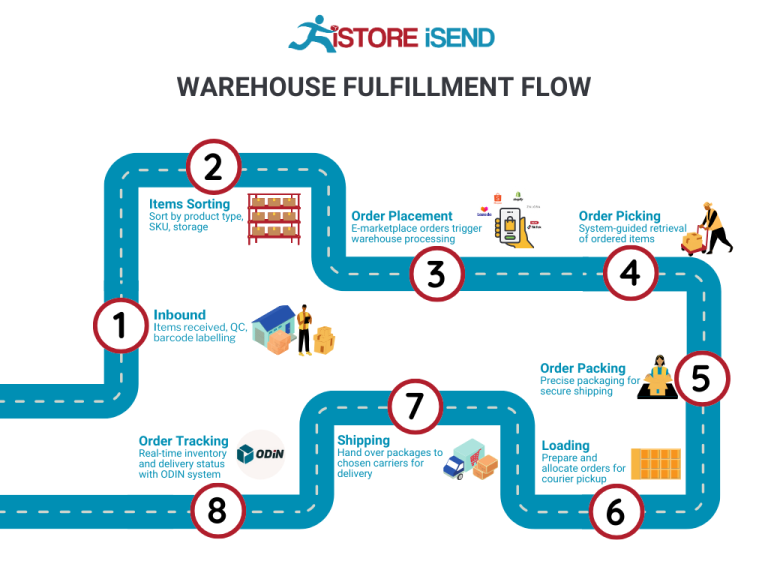
Importance: Efficient order picking is essential for timely delivery and customer satisfaction. The speed and accuracy of this process directly impact your ability to meet delivery promises. An effective picking strategy, such as zone picking or wave picking, can significantly enhance productivity and reduce errors.
Key Term: Pick List – A document that outlines the items and quantities needed for each order, serving as a guide for warehouse staff during the picking process.
4. Order Packing
After items have been picked, they move to the order packing stage. Here, products are carefully packed into boxes or envelopes, often using custom packaging solutions that enhance the unboxing experience. This stage may also involve including packing slips and promotional materials.
Importance: Proper packing is crucial for protecting items during transit and ensuring they arrive at the customer’s door in perfect condition. Additionally, well-branded packaging can elevate the customer experience and reinforce brand identity, which can lead to repeat purchases.
Key Term: Packing Slip – A document that accompanies the shipment, detailing the items included in the order, which helps to confirm that the correct products have been sent to the customer.
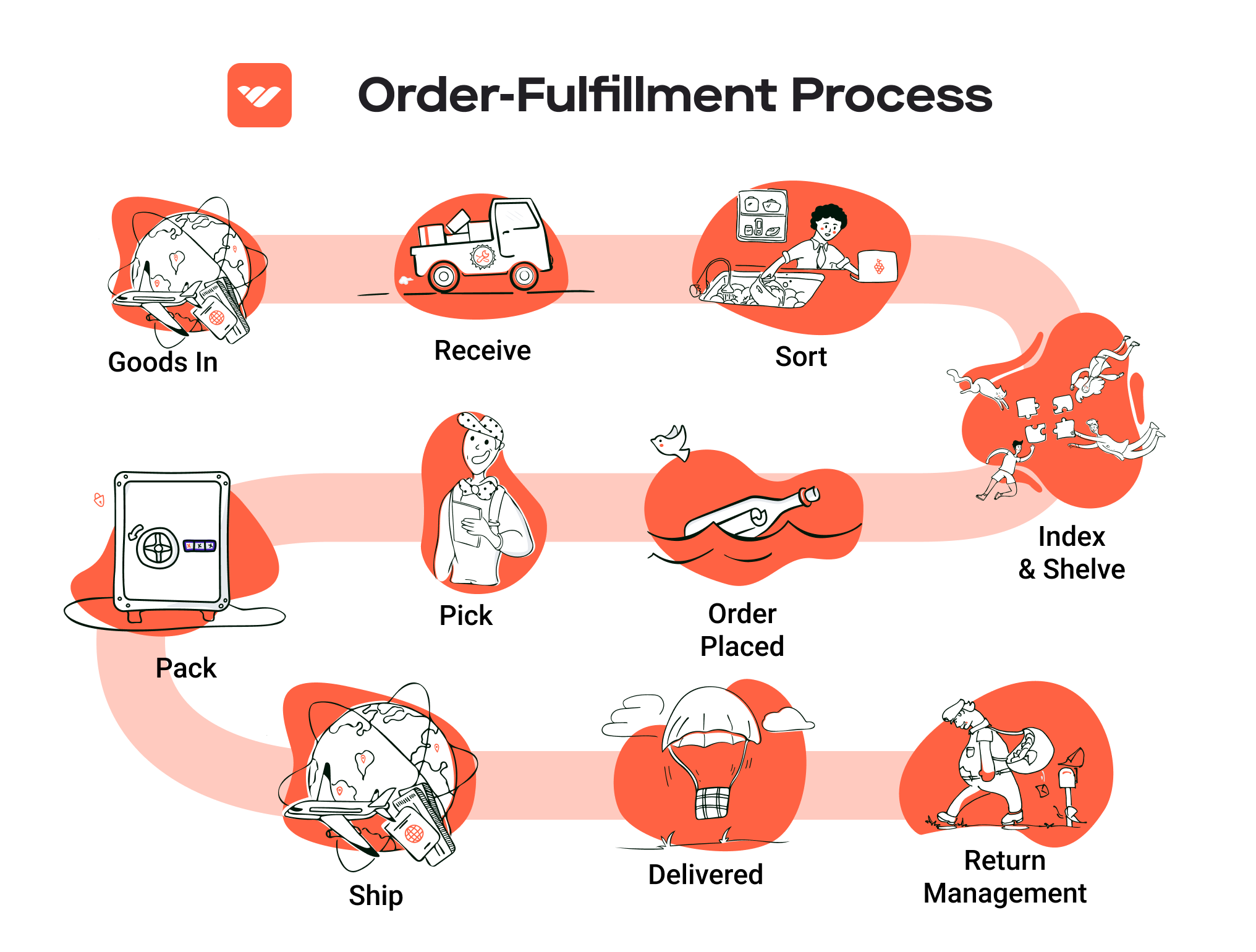
5. Shipping & Delivery
The final step in the fulfillment process is shipping and delivery. Once the order is packed, it is handed over to a shipping carrier for delivery to the customer. This phase includes labeling packages, generating shipping manifests, and selecting the most efficient shipping methods based on cost and delivery time.
Importance: Efficient shipping and delivery are vital for customer satisfaction. Timely delivery can significantly impact customer loyalty, while delays can result in negative reviews and lost sales. Offering various shipping options, including expedited services, can cater to different customer needs and preferences.
Key Term: Last-Mile Delivery – The final step in the shipping process where the package is transported from a transportation hub to the final delivery destination, which is often the most critical and complex part of the delivery process.
By understanding and optimizing each step of the order fulfillment process, e-commerce businesses can enhance their operational efficiency, reduce costs, and ultimately improve customer satisfaction. This comprehensive approach ensures that every order is processed smoothly, from the moment the customer clicks the ‘buy’ button to when the package arrives at their door.
Comparing Fulfillment Models: In-House vs. 3PL vs. Dropshipping
Fulfillment Model Comparison
| Model | Who Handles Inventory | Best For (Business Stage) | Key Advantage | Key Disadvantage |
|---|---|---|---|---|
| In-House Fulfillment | The business itself | Established businesses with stable sales | Full control over inventory and processes | High operational costs and resource demands |
| Third-Party Logistics (3PL) | Third-party provider | Growing businesses and startups | Scalability and expertise in logistics | Less control over fulfillment processes |
| Dropshipping | Supplier | New businesses and low-risk models | Low startup costs and minimal inventory | Lower profit margins and dependency on suppliers |
In-House Fulfillment
In-house fulfillment involves a business managing its own warehousing, inventory, and shipping processes. This model is typically suited for established businesses that have stable sales and adequate resources to manage their logistics operations. The primary advantage of in-house fulfillment is the complete control it offers over the entire supply chain. Businesses can implement personalized processes, ensure quality control, and maintain direct oversight of inventory levels. This can enhance customer satisfaction through faster response times and tailored services.
However, the drawbacks of in-house fulfillment can be significant. Operating a fulfillment center requires substantial investment in warehouse space, inventory management systems, and skilled labor. As a business scales, these operational costs can increase, leading to financial strain. Additionally, managing logistics in-house can divert focus from core business activities such as marketing and product development, potentially hindering growth.
Third-Party Logistics (3PL)
Third-party logistics (3PL) providers, such as Stockmatic and Salesupply, offer comprehensive fulfillment solutions that allow e-commerce businesses to outsource their logistics operations. This model is ideal for growing businesses and startups that may not have the infrastructure or expertise to manage fulfillment in-house. Key advantages of using a 3PL include scalability, as businesses can easily adjust their fulfillment needs according to demand, and access to specialized logistics expertise, which can streamline operations and reduce costs.
3PL providers often offer a range of services, including inventory management, order processing, and returns handling, which can significantly improve efficiency. Additionally, many 3PLs have established relationships with shipping carriers, enabling businesses to benefit from discounted rates and faster delivery times. However, the main disadvantage is the reduced control over fulfillment processes. Businesses may face challenges related to communication, quality assurance, and dependency on the provider’s performance. It’s essential for businesses to choose a reputable 3PL partner to mitigate these risks.
Dropshipping
Dropshipping is a fulfillment model where a business sells products without holding inventory. Instead, when a customer places an order, the business purchases the item from a third-party supplier, who then ships it directly to the customer. This model is particularly attractive for new businesses and entrepreneurs looking to minimize risk and startup costs. The primary advantage of dropshipping is that it requires little upfront investment in inventory, allowing entrepreneurs to test product viability without significant financial commitment.
However, dropshipping also comes with its challenges. One of the most significant drawbacks is the lower profit margins, as businesses typically pay a premium for the convenience of not holding inventory. Additionally, reliance on suppliers can lead to issues with product availability, shipping delays, and quality control, which can negatively impact customer satisfaction. Entrepreneurs must also be cautious about the level of competition in the dropshipping space, as many businesses may be selling similar products from the same suppliers.
Conclusion
In conclusion, choosing the right fulfillment model is critical for e-commerce businesses aiming to scale their operations effectively. Each model—In-House Fulfillment, Third-Party Logistics, and Dropshipping—offers unique advantages and disadvantages that should be carefully evaluated based on the business’s stage, resources, and long-term goals. By understanding these differences, business owners can make informed decisions that align with their operational needs and growth strategies.
A Deep Dive into Amazon FBA: Pros, Cons, and Who It’s For
Understanding Fulfillment by Amazon (FBA)
Fulfillment by Amazon (FBA) is a service provided by Amazon that enables sellers to store their products in Amazon’s fulfillment centers. Amazon takes care of storage, packaging, shipping, and customer service on behalf of the sellers. This allows e-commerce businesses to leverage Amazon’s extensive logistics network, making it easier to reach a vast audience while focusing on scaling their operations.
How FBA Works
-
Product Listing: Sellers create product listings on Amazon and can choose to enroll their products in FBA.
-
Inventory Shipment: Once enrolled, sellers ship their products to Amazon’s fulfillment centers. They must adhere to Amazon’s packaging and labeling requirements, including proper FNSKU labeling.
-
Storage: Amazon stores the products in their warehouses, managing inventory levels and ensuring items are stocked and ready for shipping.
-
Order Fulfillment: When a customer places an order, Amazon picks, packs, and ships the product directly to the customer. They also handle customer inquiries and returns.
-
Customer Service: Amazon provides customer service for FBA orders, including handling returns and refunds, allowing sellers to focus on other aspects of their business.
-
Performance Metrics: Sellers can track their sales performance, inventory levels, and customer feedback through Amazon’s Seller Central dashboard.
Pros of FBA
1. Prime Eligibility
One of the most significant advantages of FBA is that products become eligible for Amazon Prime. This status can significantly boost sales, as Prime members often prefer products that offer free two-day shipping.
2. Enhanced Customer Trust
Products fulfilled by Amazon carry the assurance of Amazon’s customer service and return policies. This trust can lead to higher conversion rates, as buyers are more likely to purchase from sellers who use FBA, knowing they have robust support in case of issues.
3. Multi-Channel Fulfillment
FBA is not limited to Amazon’s marketplace. Sellers can use FBA to fulfill orders from their own websites and other sales channels, allowing for a seamless integration of inventory management across various platforms.
4. Time-Saving
By outsourcing fulfillment to Amazon, sellers can save significant time and resources. This allows them to focus on marketing, product development, and other strategic areas rather than the logistics of storage and shipping.
5. Scalability
FBA provides a scalable solution for businesses looking to grow. As sales increase, sellers can easily send more inventory to Amazon without the need to invest in additional warehousing or staffing.
Cons of FBA
1. High Fees
While FBA offers numerous benefits, it also comes with costs. Sellers incur storage fees for their inventory stored in Amazon’s warehouses, as well as fulfillment fees for each order shipped. These costs can add up quickly, particularly for low-margin products.
2. Strict Inventory Rules
Amazon imposes strict inventory management rules, including limits on the number of units a seller can send to fulfillment centers. Sellers must also maintain their inventory levels carefully to avoid long-term storage fees, which apply to items stored for over 365 days.
3. Commingling Risks
With FBA, sellers’ products may be commingled with those of other sellers. This means that a seller could receive returns or complaints regarding items that are not theirs, complicating customer service and potentially damaging their reputation.
4. Loss of Control
By relying on Amazon for fulfillment, sellers may lose some control over the customer experience. This includes packaging, branding, and the overall delivery experience, which can be crucial for building a brand identity.
5. Complexity in Returns Management
Although Amazon handles returns, the process can sometimes be cumbersome for sellers. Products returned to Amazon may not always be returned to the seller’s inventory, leading to potential losses.
Who is FBA Best For?
FBA is best suited for e-commerce business owners who meet certain criteria:
-
High Sales Volume: Sellers with a high turnover of products can benefit from the efficiencies of FBA. The more sales, the more feasible it is to offset the costs associated with FBA.
-
Brand Trust in Amazon: Businesses that want to leverage Amazon’s reputation and customer service capabilities will find FBA beneficial.
-
Multi-Channel Sellers: Sellers who operate across multiple platforms can use FBA to streamline their logistics, making it easier to manage inventory and fulfill orders from various channels.
-
Limited Time or Resources: Entrepreneurs who lack the time or resources to manage logistics independently will appreciate the convenience of FBA.
-
Products Suitable for FBA: Items that are small, lightweight, and have a steady demand tend to perform best with FBA. Sellers should evaluate their product mix to determine if FBA is the right fit.
In conclusion, Fulfillment by Amazon offers a powerful opportunity for e-commerce businesses to scale efficiently while leveraging Amazon’s logistics prowess. However, it’s essential to weigh the benefits against the potential drawbacks to determine if it aligns with your business goals and operational capacity.
Core Services Offered by Fulfillment Centers
Inventory Management & Warehousing
Inventory management and warehousing are foundational services provided by fulfillment centers that directly impact an e-commerce business’s efficiency and customer satisfaction. This service involves the systematic tracking of products from the moment they are received until they are shipped to the customer.
Fulfillment centers utilize advanced Warehouse Management Systems (WMS) to provide real-time visibility into inventory levels, helping businesses avoid stock-outs and overstock situations. By consolidating inventory in a centralized location, e-commerce businesses can streamline their operations, reduce storage costs, and ensure that products are readily available for customers.
Benefits:
1. Optimized Stock Levels: With precise inventory tracking, businesses can maintain optimal stock levels, ensuring products are available when needed without incurring unnecessary holding costs.
2. Faster Fulfillment Times: Centralized warehousing allows for quicker order processing, resulting in faster shipping times that enhance customer satisfaction.
3. Data-Driven Insights: Detailed analytics from inventory management systems enable businesses to make informed decisions regarding purchasing, sales trends, and seasonal fluctuations.
Pick and Pack Services
Pick and pack services represent the core operational process of fulfillment centers. This service involves selecting items from inventory (picking) and preparing them for shipment (packing). Fulfillment centers employ trained staff and automated systems to ensure accuracy and efficiency in this process.
When an order is placed, the fulfillment center quickly identifies the items needed, picks them from the shelves, and packages them according to the business’s specifications. This service can be tailored to include branded packaging, gift wrapping, or eco-friendly materials, depending on the business’s needs.
Benefits:
1. Increased Accuracy: Professional pick and pack services significantly reduce the risk of shipping errors, ensuring customers receive the correct items.
2. Scalability: As a business grows, fulfillment centers can easily scale their pick and pack operations to handle increased order volumes without compromising service quality.
3. Enhanced Customer Experience: Efficient pick and pack services contribute to faster delivery times, which can lead to higher customer satisfaction and repeat business.
Kitting and Assembly
Kitting and assembly are value-added services that involve grouping multiple products into a single package or preparing components for a final product. This is particularly beneficial for businesses that sell bundled products or require assembly before shipping, such as cosmetics sets or electronics.
Fulfillment centers can manage the entire kitting process, from receiving individual components to assembling them into finished products ready for sale. This service not only streamlines operations but also allows businesses to offer unique product combinations that can attract more customers.
Benefits:
1. Increased Sales Opportunities: By offering bundled products or customized kits, businesses can differentiate themselves in a crowded marketplace and potentially increase average order value.
2. Time Savings: Outsourcing kitting and assembly allows businesses to focus on core activities such as marketing and product development while leaving complex logistical tasks to fulfillment experts.
3. Improved Inventory Management: Kitting can simplify inventory management by reducing the number of individual SKUs a business needs to track, allowing for more efficient stock control.
Returns Management (Reverse Logistics)
Returns management, or reverse logistics, is an essential service offered by fulfillment centers that handles the process of returns from customers. Efficient returns management is crucial for maintaining customer satisfaction and loyalty, as a seamless return process can encourage repeat purchases.
Fulfillment centers manage every aspect of returns, including receiving returned items, inspecting their condition, restocking inventory, and processing refunds or exchanges. This service can also include refurbishing or repairing items that can be resold, thereby minimizing losses for the e-commerce business.
Benefits:
1. Enhanced Customer Loyalty: A hassle-free return process builds trust and encourages customers to shop again, knowing that their satisfaction is a priority.
2. Cost Efficiency: Effective returns management helps minimize the costs associated with returns, such as shipping and restocking fees, by ensuring that products are quickly returned to inventory.
3. Data Insights: Analyzing return patterns can provide valuable insights into product quality and customer preferences, enabling businesses to make informed decisions about inventory and product offerings.
By leveraging these core services, e-commerce businesses can optimize their operations, reduce costs, and enhance the overall customer experience. Partnering with a reliable fulfillment center allows businesses to focus on growth and innovation while ensuring that their logistics and fulfillment processes run smoothly and efficiently.
How to Choose a Fulfillment Partner: A 6-Point Checklist
Location & Warehouse Network
Importance: The geographical location of your fulfillment partner’s warehouses can significantly affect shipping times and costs. A partner with strategically placed warehouses can help you reach your customers faster and at a lower shipping rate.
Questions to Ask:
– Where are your warehouses located, and do they cover the regions where my primary customer base is situated?
– What is your average shipping time to major cities from your warehouses?
– Do you have plans to expand your warehouse network in the future?
Technology & Integrations
Importance: In today’s digital landscape, a seamless technology integration with your e-commerce platform is crucial for efficient order processing and inventory management. A robust technology stack can help automate workflows, reduce errors, and provide real-time visibility into your operations.
Questions to Ask:
– What technology platforms do you support for integrations (e.g., Shopify, Amazon, WooCommerce)?
– Can your system provide real-time inventory tracking and order status updates?
– Do you offer a user-friendly dashboard for managing orders and inventory?
Specializations (e.g., cold storage, oversized items)
Importance: Depending on your product type, you may need a fulfillment partner with specific capabilities. For instance, if you sell perishable goods, you’ll need a partner that offers cold storage. Similarly, if your products are oversized or require special handling, ensure your partner has the necessary expertise.
Questions to Ask:
– Do you have specialized facilities for my product type, such as climate-controlled storage for perishables?
– How do you handle products that require special packaging or handling?
– Can you accommodate seasonal fluctuations in product demand?
Scalability & Capacity
Importance: As your business grows, your fulfillment needs will evolve. A good partner should be able to scale operations to accommodate increasing order volumes without compromising service quality. Assessing their capacity to handle growth is essential for long-term success.
Questions to Ask:
– What is your current capacity, and how do you manage peak seasons or unexpected surges in demand?
– Can you provide examples of how you’ve scaled operations for other clients?
– What is your process for onboarding new products or categories?
Pricing and Contracts
Importance: Understanding the pricing structure and contract terms is vital to avoid unexpected costs that can eat into your margins. Transparency in pricing and flexibility in contracts can provide peace of mind and allow for better financial planning.
Questions to Ask:
– Can you break down your pricing model (e.g., per order, storage fees, shipping costs)?
– Are there any hidden fees I should be aware of, such as for returns or special handling?
– What are the terms of your contract, and do you offer flexible month-to-month agreements?
Customer Support & Reviews
Importance: A reliable fulfillment partner should provide excellent customer support, as issues can arise that require immediate attention. Additionally, checking reviews and testimonials can offer insights into their service quality and reliability.
Questions to Ask:
– What customer support channels do you offer (e.g., phone, email, chat), and what are your response times?
– Can you provide references or case studies from businesses similar to mine?
– How do you handle disputes or issues that arise during the fulfillment process?
Conclusion
Choosing the right fulfillment partner can significantly impact your e-commerce operations, customer satisfaction, and overall business growth. By using this checklist, you can ensure that you thoroughly evaluate potential partners based on critical aspects that align with your business needs. Take the time to ask the right questions, assess their responses, and make an informed decision that will support your scaling efforts effectively.
Understanding Fulfillment Pricing: A Breakdown of Common Fees
Initial Setup Fees
Initial setup fees are typically one-time charges incurred when you begin using a fulfillment service. These fees cover the costs associated with onboarding your business onto the fulfillment provider’s system. This may include:
- Account Setup: Creating your account in the fulfillment system, which often involves entering your business details, payment information, and preferences.
- Integration Fees: Costs associated with integrating your e-commerce platform (like Shopify, Amazon, or WooCommerce) with the fulfillment center’s technology. This can involve software adjustments and custom configurations to ensure seamless order processing.
- Training Fees: Some providers may charge for training sessions to familiarize your staff with the fulfillment platform and processes.
The exact amount for initial setup fees can vary significantly based on the complexity of your requirements and the provider’s pricing structure. It’s crucial to clarify these fees upfront to avoid unexpected costs.
Receiving Fees
Receiving fees are charged for the process of accepting and storing your inventory at the fulfillment center. These fees may cover:
- Unloading and Inspection: The time and labor required to unload incoming shipments and inspect goods for quality and accuracy.
- Inventory Entry: The process of entering items into the inventory management system, ensuring that everything is properly tracked and accounted for.
Receiving fees can be calculated on a per-pallet or per-box basis, or sometimes as a flat fee for each shipment. Understanding how these fees are structured can help you anticipate costs, especially if you have frequent shipments of varying sizes.
Storage Fees (per pallet/bin)
Storage fees are ongoing costs associated with keeping your inventory at the fulfillment center. These fees can vary based on factors such as:
- Type of Storage: Fees may differ for standard pallet storage versus bin storage, with pallets typically costing more due to the higher volume they occupy.
- Duration of Storage: Many fulfillment centers charge monthly fees based on how long your products are stored. This can be a flat monthly fee or calculated on a per-pallet or per-cubic-foot basis.
It’s important to manage your inventory levels to minimize storage costs, as excess inventory can lead to increased fees. Additionally, some providers offer discounted rates for long-term storage, which can be beneficial for businesses with seasonal inventory.
Pick & Pack Fees (per item/order)
Pick and pack fees are charged for the labor involved in retrieving items from storage and preparing them for shipment. This process typically includes:
- Picking: The act of selecting items from the warehouse based on customer orders.
- Packing: The preparation of items for shipment, which involves boxing, labeling, and ensuring that products are securely packaged.
These fees can be structured in various ways, such as a flat fee per order or a variable fee based on the number of items picked and packed. Understanding this pricing model is essential for accurate forecasting, as high-volume orders can lead to significant costs.
Shipping Fees
Shipping fees are a crucial part of fulfillment costs and can vary widely depending on several factors:
- Carrier Rates: Costs are determined by the shipping carrier (e.g., UPS, FedEx, USPS), and can vary based on service level (standard, expedited, etc.).
- Destination: Shipping costs can increase based on the distance to the delivery location. Rates may differ for domestic versus international shipping.
- Package Size and Weight: Heavier and larger packages typically incur higher shipping costs. Some providers may offer tiered pricing based on these factors.
To optimize shipping expenses, it’s wise to evaluate the shipping options your fulfillment partner provides and consider negotiating rates if you have high shipping volumes.
Tips for Getting an Accurate Quote
-
Provide Detailed Information: When requesting a quote, be clear about your business model, expected order volumes, and specific needs (like custom packaging or returns management). This helps providers give you a tailored estimate.
-
Ask About Hidden Fees: Ensure you understand all potential costs, including initial setup, storage, and additional services. A transparent pricing structure is crucial for accurate budgeting.
-
Compare Multiple Providers: Don’t settle for the first quote. Compare offers from several fulfillment centers to ensure you’re getting competitive pricing and services that align with your business goals.
-
Consider Long-Term Needs: Think about how your fulfillment needs may change as you scale. Some providers offer discounts for long-term contracts or higher volumes, which can save you money in the long run.
-
Request a Trial Period: If possible, consider negotiating a trial period with the fulfillment provider. This allows you to assess their services without committing to a long-term contract, ensuring they meet your operational needs before you fully engage.
By understanding these common fees and asking the right questions, you can make informed decisions that support your business’s growth and efficiency in the e-commerce landscape.
Frequently Asked Questions (FAQs) about Fulfillment
1. What is e-commerce fulfillment?
E-commerce fulfillment refers to the entire process of receiving, processing, and delivering orders to customers. This includes inventory management, order picking and packing, shipping, and handling returns. Efficient fulfillment is crucial for customer satisfaction and can significantly impact the success of an online business.
2. What is a fulfillment center?
A fulfillment center is a specialized warehouse designed to store products and manage the logistics of order processing. Unlike traditional warehouses, fulfillment centers focus on efficiently receiving, storing, picking, packing, and shipping products directly to customers, often integrating with e-commerce platforms for streamlined operations.
3. What’s the difference between a warehouse and a fulfillment center?
While both warehouses and fulfillment centers store products, their purposes differ. Warehouses primarily focus on long-term storage and inventory management, whereas fulfillment centers are geared towards quick order processing and shipping. Fulfillment centers often offer additional services like returns management and real-time inventory tracking, which are essential for e-commerce operations.
4. What is a 3PL (Third-Party Logistics)?
A 3PL, or third-party logistics provider, is a company that offers outsourced logistics services to businesses. This includes warehousing, order fulfillment, inventory management, and shipping. Utilizing a 3PL allows e-commerce businesses to focus on their core operations while leveraging the expertise and resources of logistics professionals.
5. How much do fulfillment services cost?
The cost of fulfillment services varies based on several factors, including order volume, storage space, shipping methods, and additional services like returns management. Typically, fulfillment costs can range from $2 to $5 per order, plus storage fees that can vary from $10 to $50 per pallet per month. It’s essential to request quotes from multiple providers to find a solution that fits your budget.
6. How can I choose the right fulfillment partner in Miami?
When selecting a fulfillment partner in Miami, consider factors such as their experience in e-commerce, technology integrations, shipping capabilities, customer support, and pricing structure. Look for partners that offer flexible solutions tailored to your business needs and that have a proven track record of reliability and efficiency.
7. What are the benefits of outsourcing fulfillment?
Outsourcing fulfillment can lead to cost savings, improved efficiency, and enhanced customer satisfaction. By partnering with a fulfillment provider, businesses can reduce operational overhead, access advanced logistics technology, and benefit from the provider’s expertise in shipping and inventory management. This allows companies to focus on growth and customer engagement.
8. How does real-time inventory management work?
Real-time inventory management involves using technology to track inventory levels as they change. This means you can see stock levels, sales, and order statuses in real-time, helping you avoid stockouts or overstock situations. Many fulfillment centers offer integrated systems that sync with your e-commerce platform for seamless inventory updates.
9. What should I look for in a returns management process?
An effective returns management process should be easy for customers to navigate, fast, and cost-efficient. Look for fulfillment partners that offer same-day refunds, streamlined return-to-stock processes, and options for product refurbishment if necessary. A robust returns process can enhance customer satisfaction and encourage repeat business.
10. Can I integrate my e-commerce platform with a fulfillment service?
Yes, most fulfillment services in Miami offer integrations with popular e-commerce platforms like Shopify, Amazon, WooCommerce, and others. These integrations enable seamless data transfer, automate order processing, and provide real-time inventory updates, helping you streamline operations and improve overall efficiency.
Conclusion: Is Outsourcing Fulfillment the Right Move for Your Business?
Evaluating the Benefits of Outsourcing Fulfillment
Outsourcing fulfillment can be a transformative decision for e-commerce businesses looking to scale effectively. By partnering with a dedicated fulfillment service, you can save significant time and resources that would otherwise be spent on logistics. This allows you to focus on core business activities, such as product development and marketing, ultimately driving growth and enhancing customer engagement.
One of the most compelling advantages of utilizing a fulfillment service is scalability. As your business grows, so do your logistics needs. A professional fulfillment partner can adjust to fluctuating order volumes seamlessly, ensuring that you can meet customer demand without the headache of managing warehousing and shipping logistics yourself. This flexibility is crucial in today’s fast-paced e-commerce environment, where consumer expectations are continually rising.
Moreover, fulfillment services bring expertise to the table. With established processes for order management, inventory control, and returns handling, these partners help streamline operations and improve efficiency. They also offer insights through analytics and reporting, enabling data-driven decisions that can enhance your supply chain strategy.
However, the success of outsourcing fulfillment hinges on selecting the right partner. Look for a fulfillment provider that aligns with your business goals, offers transparent pricing, and integrates smoothly with your existing systems. The right partner will not only facilitate your current operations but will also support your long-term growth strategy.
Take Action
To determine whether outsourcing fulfillment is the right next step for your business, consider auditing your current shipping and logistics processes. Evaluate your inventory management, shipping times, and customer satisfaction levels. If you find inefficiencies or limitations, it may be time to explore the benefits of partnering with a fulfillment service that can propel your business forward. Start your journey towards streamlined operations today!
Important Disclaimer
⚠️ Important Disclaimer
The information in this guide is for educational purposes. Fulfillment services, pricing, and platform features change frequently. Always conduct your own due diligence and consult with providers directly before making business decisions.

